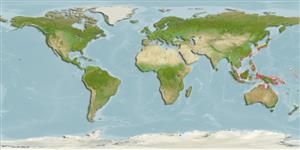>
Blenniiformes (Blennies) >
Blenniidae (Combtooth blennies) > Salariinae
Etymology: Entomacrodus: Greek, ento = inside + Greek, makros = big + Greek, odous = teeth (Ref. 45335).
Eponymy: Dr Sol Felty Light (1886–1947) was an American zoologist who taught at the University of California, Berkeley. [...] (Ref. 128868), visit book page.
More on author: Herre.
Environment: milieu / climate zone / depth range / distribution range
Ecologia
marinhas demersal; intervalo de profundidade 0 - 3 m (Ref. 90102). Subtropical
Western Pacific: South China Sea and Gulf of Thailand.
Tamanho / Peso / Idade
Maturity: Lm ? range ? - ? cm
Max length : 11.8 cm FL macho/indeterminado; (Ref. 90102)
Descrição suscinta
Chaves de identificação | Morfologia | Morfometria
Espinhos dorsais (total) : 13; Raios dorsais (total) : 15 - 16; Espinhos anais: 2; Raios anais : 16 - 18. Pale olive grey with 3 broad, dusky bands radiating from eye, series of H-shaped dark bars on side of body, and large black spot distally between first and second dorsal spines. Dorsal fin deeply notched; anal rays rarely 16; pectoral rays usually 14; pelvic spine not visible externally; last lateral-line tube below 10th dorsal spine to caudal peduncle; nape with 1 cirrus on each side; supraorbital tentacle blade-like without cirri; anterior nostril cirri present posteriorly; upper lip margin crenulate medially; body depth at anal-fin origin about 5.0 in SL (Ref. 90102).
Facultative air-breathing in the genus (Ref. 126274); Adults are found on exposed rocky coasts in the intertidal zone to 3 m deep (Ref. 90102). Oviparous. Eggs are demersal and adhesive (Ref. 205), and are attached to the substrate via a filamentous, adhesive pad or pedestal (Ref. 94114). Larvae are planktonic, often found in shallow, coastal waters (Ref. 94114).
Ciclo de vida ou comportamento de acasalamento
Maturidade | Reprodução | Desova | Ovos | Fecundidade | Larvas
Oviparous, distinct pairing (Ref. 205).
Springer, V.G., 1967. Revision of the circumtropical shorefish genus Entomacrodus (Blennidae: Salariinae). Proc. U.S. Natl. Mus. 122(3582):150 p. (Ref. 40910)
Status na Lista Vermelha da UICN (Ref. 130435: Version 2024-2)
Ameaça para os humanos
Harmless
Uso pelos humanos
Ferramentas
Relatórios especiais
Baixar XML
Fontes da internet
Estimates based on models
Preferred temperature (Ref.
123201): 25.1 - 29.2, mean 28.8 °C (based on 988 cells).
Índice de diversidade filogenética (Ref.
82804): PD
50 = 0.5000 [Uniqueness, from 0.5 = low to 2.0 = high].
Bayesian length-weight: a=0.00776 (0.00356 - 0.01695), b=3.00 (2.81 - 3.19), in cm total length, based on LWR estimates for this (Sub)family-body shape (Ref.
93245).
Nível Trófico (Ref.
69278): 2.0 ±0.00 se; based on food items.
Resiliência (Ref.
120179): Elevada, tempo mínimo de duplicação da população menor que 15 meses (Preliminary K or Fecundity.).
Fishing Vulnerability (Ref.
59153): Low vulnerability (10 of 100).
